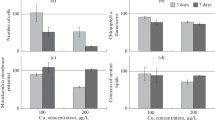Abstract
One of the best-known features of diatom biology is the reduction in mean cell size during vegetative multiplication by binary fission. We examined changes in copper toxicity and copper accumulation during cell-size reduction in Haslea ostrearia (Simonsen), a pennate diatom responsible for greening in oyster-ponds. We selected three strains with apical axes of different lengths: 40 μm (S40), 65 μm (S65) and 85 μm (S85). Each strain was grown separately in batch culture and exposed to a range of copper overloads (0 to 1.57 μM) that were added to the culture immediately after cell inoculation. Significant differences in sensitivity to copper were observed among the three strains. S85 exhibited highest sensitivity, followed by S40, while S65 displayed the highest tolerance. After 5 to 6 d exposure to 0.47 μM copper, chlorophyll a, carbohydrate, protein and lipid content per g dry weight had not changed in any of the three strains studied, except for a decrease of 16% in chlorophyll a in S85. At the end of the growth period with 0.47 μM copper, the amount of metal per unit surface area was similar for all strains, but the quantity of intracellular copper per g dry weight was lower in S65 cells than in S40 and S85 cells. Notable differences in the kinetics of both adsorbed and intracellular copper were observed between S40 and S85. Our results suggest that tolerance mechanisms may change during the vegetative life of H. ostrearia. The differential sensitivities of the strains suggest that copper pollution may alter the cell composition of natural populations of H. ostrearia by inducing selection for smaller cell size. Since auxosporulation results in the formation of larger cells with a higher sensitivity to copper, H. ostrearia could gradually disappear from copper-contaminated environments. In addition, by inducing smaller cell size, copper contamination would have an impact on filter-feeders such as oysters, whose diet is largely composed of diatoms.
Similar content being viewed by others
Author information
Authors and Affiliations
Additional information
Received: 26 March 1999 / Accepted: 2 December 1999
Rights and permissions
About this article
Cite this article
Joux-Arab, L., Berthet, B. & Robert, JM. Do toxicity and accumulation of copper change during size reduction in the marine pennate diatom Haslea ostrearia?. Marine Biology 136, 323–330 (2000). https://doi.org/10.1007/s002270050690
Issue Date:
DOI: https://doi.org/10.1007/s002270050690




